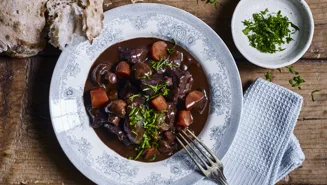
Greek yogurt is a yogurt type originating in Greece. It is made from Greek milk in Greece, but other countries make Greek-style yogurt inspired by the Greek version.
Greek yogurt and Greek-style yogurt are both known for their rich, creamy texture and tangy taste. It is typically consumed as a standalone snack, used as a base for sauces, dips, or dressings, or incorporated into various recipes. It can be used as an alternative to, for example, crème fraiche or mayonnaise in recipes, thanks to its lower fat content and higher protein content.
Greek yogurt is often compared to skyr as they share some similarities. If you want to know more, you can read our article What is skyr? or check out our comparison of skyr and Greek yogurt, where we highlight similarities and differences.
What is Greek-style yogurt compared to Greek yogurt?
Greek-style yogurt and Greek yogurt are terms that are often used interchangeably, but they are not the same. In short: to be labelled Greek yogurt, the product must be produced in Greece from Greek ingredients. If this is not the case, it can be called Greek-style yogurt.
Greek-style yogurt refers to a strained dairy product made using a process similar to the one used for Greek yogurt. It generally involves removing whey from regular yogurt, resulting in a thicker texture. However, Greek-style variations may not undergo the same specific production methods or possess the identical nutrient profile as authentic Greek yogurt. And most importantly: it does not meet the requirements of the origin of ingredients and the location of production.
What to make with Greek yogurt?
The versatility makes the Greek dairy darling an ingredient that can be used in a wide range of recipes, allowing for endless creativity in the kitchen. Its creamy texture and tangy flavour make it an excellent addition to a variety of dishes.
Greek yogurt or Greek-style yogurt is often incorporated into breakfast recipes, offering a wholesome start to the day. Both can be used in parfaits, creating layers with fresh fruits, granola, and a drizzle of honey. Other options include incorporating it into smoothies, blending it with fruits and vegetables, or even using it as a substitute for buttermilk or milk in pancake batter. This substitution adds a tangy flavour and a moist texture to the pancakes.

A classic use of Greek or Greek-style yogurt is in the preparation of tzatziki. The traditional Greek dip combines Greek yogurt with grated cucumber, garlic, lemon juice, and dill. It pairs wonderfully with grilled meats and vegetables, but it can also be served as a condiment, for example, with bread. But the party does not end with tzatziki. In general, Greek yogurt is a good addition to dressings, dips, and spreads. You can mix it with herbs, spices, or roasted vegetables to create accompaniments to any meal.

When it comes to baking, it can be used as a substitute for certain dairy products. It contributes wonderfully to moist and flavourful baked goods such as muffins, cakes, and breads. Additionally, it can easily be transformed into delightful frozen treats. Use it as a base for homemade ice cream or frozen yogurt, incorporating your favourite fruits, nuts, or chocolate for added flavour.

If you are looking for more inspiration for cooking with alternative dairy products, perhaps you can find some in our article Can you cook with skyr? You can also consider using kefir or quark in your favourite recipes.
Whipped Greek yogurt
Try whipping Greek yogurt with a hand mixer or a hand blender. Beat until it becomes light and fluffy. You can also do it by hand with a whisk, but it can be difficult to reach the same airy mousse-like texture.
When whisked, it increases in volume and becomes soft, making it the perfect topping for desserts, fruit salads, or breakfast bowls. It serves perfectly as an alternative to whipped cream or frosting, but you can also add it as an extra element of fluff and delight.







































